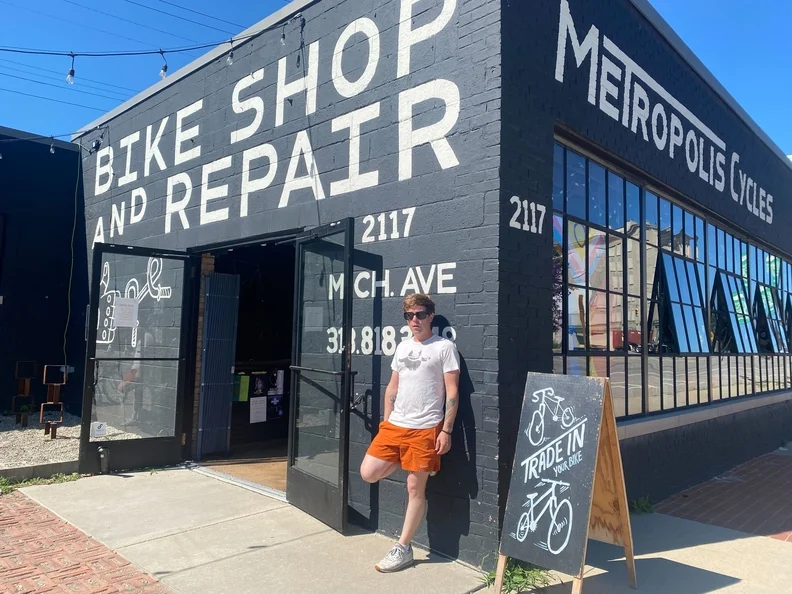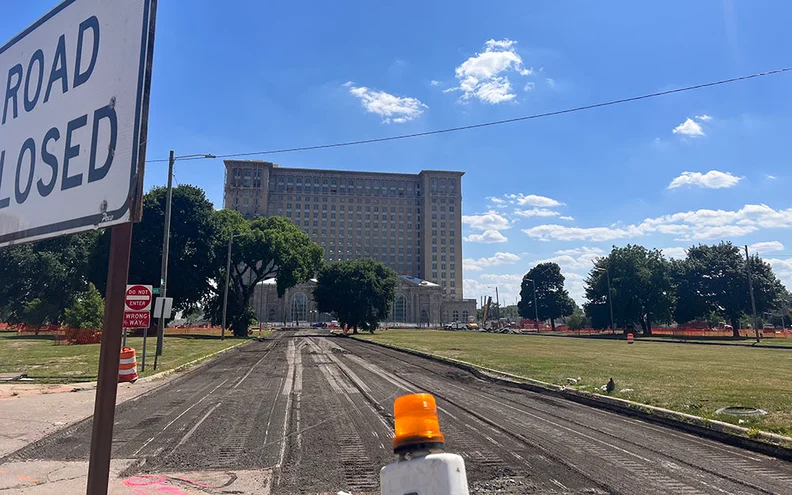August 24, 2022

Crain’s Detroit Business
Amelia Benavides-Colón
Aug. 9, 2022

Amelia Benavides-Colón / Crain’s Detroit Business
As the hulking skeleton of the Michigan Central Depot in Corktown continues to undergo a $740 million rehabilitation by Ford Motor Company into an EV campus and “innovation district,” other developments along that stretch to the south have followed suit.
The influx of development and outside dollars has some long-standing community members and business owners searching for a place amid the changes. And as new residents flow into the neighborhoods, that’s raised worries about whether the culture at the heart of the community may get lost among the bricks and backhoes.
Southwest Detroit, the borders of which have long been in debate but generally stretch southwest from the train station and includes the ZIP codes 48216, 48209, 48210, and 48217, is a community rich in Latino culture, says Charlotte Carrillo, vice president of the Southwest Detroit Business Administration.
“I think that by inviting these new businesses they start to appreciate our culture, they start to learn our culture, they start to honor our culture, (and) I think that that’s important,” Carrillo said.
Southwest Detroit Business Administration (SDBA), a coalition of small businesses in southwest Detroit, was established in 1957 and has helped facilitate community engagement in its boundaries ever since. Currently the SDBA operates the Mexican Town Main Street program, West Vernor and Springwells Business Improvement District, and the commercial corridors of Michigan Avenue between I-96 and I-75.
Ford is on schedule to complete the rehab of Michigan Central Station by mid-2023 and surrounding businesses are growing to match the new campus.
SDBA is launching its La Joya Gardens project, which will be a majority-affordable housing apartment complex on W. Vernor Highway; 42 of the 53 units will be affordable, said Carrillo, and the project is expected to break ground this fall.
“It will be a mixed-used (building) so affordable, fair market, and then we’ve got some commercial property going in there as well,” Carrillo said. “So, it’s about two blocks and the first-floor front will be commercial.”
Across from Michigan Central Station, Corktown residents Nicole Stopka-Nichols and Chris Nichols have broken ground on SteelHaus, a three-level, mixed-used building made out of shipping containers.

Amelia Benavides-Colón / Crain’s Detroit Business
City officials last month broke ground on a $6 million redesign of Roosevelt Park in front of the train station with plans to expand it from 9.5 acres to 13 acres by next spring. The park is currently bisected by a section of Vernor Highway, which is being removed from the middle of the park and redirected. The project also includes plans for a promenade connecting Michigan Avenue to Michigan Central Station, a new pedestrian gateway entrance at Michigan Avenue, plaza spaces, event lawns, and additional seating.
Nearby at 1611 Michigan Ave., Farmington Hills-based developer Oxford Perennial has begun building a 188-unit apartment complex with ground-level retail space. A block over from the complex will be The Godfrey, a new boutique hotel featuring 227 rooms and a rooftop restaurant, which has broken ground at 1401 Michigan Ave. This location will be The Godfrey’s fifth location in the country, including hotels in Chicago and Boston.
Among the newest offerings are Denise Lopez and Diane Brown’s Michigan Squeeze Station. The residents of southwest Detroit had a vision for a shared community space, equipped with a smoothie bar and an outdoor yard for activities. In 2019, the perfect location along Michigan Avenue opened up and they felt the time was right to make their dreams a reality.
“We’ve been here through the pandemic, we opened in April 2020 and our business is growing every month,” said Lopez.
In addition to its assortment of fruit smoothies, The Michigan Squeeze Station has an outdoor patio used by local artists and vendors. The program offerings range from cardio drumming to Zumba, and dance classes have proven popular with the community, they said.

CoStar Group Inc.
Southwest Detroit may be known for its large population of Latino residents, but that area of the city has had a long history as a haven for immigrants.
In fact, Corktown is considered Detroit’s oldest existing neighborhood, formed when Irish immigrants fleeing the Great Irish Potato Famine in the 1840s filled the area. Today, Detroit’s Gaelic League/Irish American Club, founded in 1920, stands at the corner of Michigan Avenue and 14th Street and serves as a reminder of the neighborhood’s history.
Around 1900, a large number of Maltese immigrants moved into the area, drawn in by the booming auto industry due to the formation of Ford in 1903. Since the 1920s, the neighborhood has largely remained Latino with strong organizations forming including SDBA, Southwest Solutions, Congress of Communities, and the Corktown Neighborhood and Business Associations.
Michigan Central Station, originally constructed in 1913 in Detroit’s Corktown neighborhood, served as the primary railway depot for the city from 1913 to 1988, according to the Detroit Historical Society. The station was built to accommodate an increase in rail traffic from the Detroit-Windsor rail tunnel, which opened in 1910.
The building consists of a three-story depot with 10 gates for trains and an 18-story tower with more than 500 offices. The final train departed from the station in 1988, mostly due to a decline in railway travel due to the popularization of airplanes and highways.
It was added to the National Register of Historic Places in 1975.
The building sat vacant and decaying for decades, becoming an icon of Detroit’s economic decline particularly as it declared bankruptcy in 2013 and a favorite site for those urban explorers looking to highlight ruin porn in the city.
In 2018, Ford purchased the building and has since revealed plans for an elaborate 30-acre, walkable district of commercial real estate, workspaces for 5,000, high-tech connected infrastructure and a state-of-the-art testing environment, according to its website.

Minnah Arshad/Crain’s Detroit Business
But change isn’t great for everyone.
Shayne O’Keefe, co-owner of Metropolis Cycles, located at Michigan Avenue and 14th Street next to Roosevelt Park, said the construction at the train station isn’t the best environment for bikers.
Metropolis Cycles first opened in 2014, four years before Ford paid $90 million for the Michigan Central Station.
“Since they’ve started construction it’s definitely dirtier around,” O’Keefe said. “Plus rent is still going up.”
O’Keefe said his rent has been increasing each year since opening.
Ryan Cooley, owner of O’Connor Real Estate in Corktown, said the rising rates aren’t directly tied to Ford’s ties with Michigan Central Station.
“It’s more of the right market… Ford is coming and bringing a new campus to the area and that’s drawing people in,” he said.
When the pandemic halted business, O’Keefe was able to stay open as bike riding became a popular hobby, and sales increased by 40%, he said.
Carrillo said she wants local businesses to use SDBA as a resource in connecting with the area’s new residents.
“Our goal is to continue fostering that relationship and just that connectivity between Ford Motor Company and the businesses and a resident of Southwest Detroit,” she said. “Our plan is to help them understand the community, and to help them develop a strategy around engaging the community, and supporting the residents and businesses in the area.”
With assistance from the Kresge Foundation in 2017, SDBA launched a pilot program offering financial assistance to business owners to convert their upper-unit apartments. The program was a success and the city is now hoping to use the program to address the city’s affordable housing problem.
Greg Mangan, real estate advocate at SDBA, estimates there are about 88 buildings in the business district with at least one vacant apartment on the second floor. He said filling them will increase density, lead more people to be out in the neighborhood and improve the incomes of landlords.
“Our theory is by doing this, it’s a way to feed a market that’s currently under-served,” Mangan told Crain’s earlier this month. “We want to prime the pump for people to do more on their own.”
It’s just one tool in the arsenal for the city of Detroit, which is working to avoid displacement of longstanding residents as the neighborhood changes and evolves — and becomes more expensive.
One such effort is the Left Field project, which is now underway after a yearlong delay. It is part of a signature redevelopment in Corktown that will bring more than 800 units to the area with the help of a $30 million competitive federal grant known as Choice Neighborhood. The project will help prevent displacement in Corktown, “which is seeing an unprecedented level of new development,” Detroit Mayor Mike Duggan said.
As a whole, the city said last month, Corktown will see $200 million invested in 842 new housing units over six years. More than 500 of those units will be considered affordable housing.
“We made a commitment to the city, we’re not going to have those who stay pushed out,” Duggan said during the groundbreaking of the Left Field project in July. “Those who were here before will always have a place to stay.”